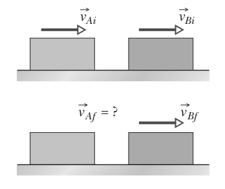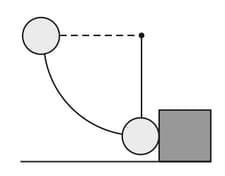In the "before" part of the figure shows below, car (mass ) is stopped at a traffic light when it is rear-ended by car (mass ). Both the cars then slide with locked wheels until the frictional force from the slick road (with a low of ) stops them at distances and . What are the speeds of (a) car and (b) car at the start of the sliding just after the collision?
(c) Assuming that the linear momentum is conserved during the collision, find the speed of car just before the collision.
(d) Explain why this assumption may be invalid.

(c) Assuming that the linear momentum is conserved during the collision, find the speed of car just before the collision.
(d) Explain why this assumption may be invalid.

Important Questions on Center of Mass and Linear Momentum
In figure show below, a ball of mass is shot with speed into the barrel of a spring gun of mass , initially at rest on a frictionless surface. The ball sticks in the barrel at the point of maximum compression of the spring. Assume that the increase in thermal energy due to friction between the ball and the barrel is negligible. (a) What is the speed of the spring gun after the ball stops in the barrel? (b) What fraction of the initial kinetic energy of the ball is stored in the spring?

In the figure shown below, block (mass ) is at rest on a frictionless surface and touching the end of an up-stretched spring of spring constant . The other end of the spring is fixed to a wall. Block (mass ), travelling at speed collides with block , and the two blocks stick together. When the blocks momentarily stop, by what distance is the spring compressed?

In figure shown below, block (mass ) is moving rightward at and block (mass ) is moving rightward at . The surface is frictionless and a spring with a spring constant of is fixed to block . When the blocks collide, the compression of the spring is maximum at the instant the blocks have the same velocity. Find the maximum compression.

In the figure shows below, block (mass ) slides into block (mass ), along a frictionless surface. The directions of their velocities before and after the collision are indicated; the corresponding speeds are and . What are the (a) speed and (b) direction (left or right) of velocity ? (c) Is the collision elastic?

Two bodies of masses, and , are connected by a long string of negligible mass. The string is looped over a pulley and, with the string taut, the bodies are released at time so that the heavier one descends and the lighter one ascends. At time , the lighter one undergoes a fully inelastic collision with a third body of mass . Because the first two bodies move in rigid fashion, the collision is effectively between the third body and the system of the first two bodies.
(a) Just after the collision, what is the speed of the three bodies?
(b) By how much was the kinetic energy of the descending body decreased because of the collision?
Two titanium spheres approach each other head-on with the same speed and collide elastically. After the collision, one of the spheres, whose mass is , remains at rest.
(a) What is the mass of the other sphere?
(b) What is the speed center of mass of the two sphere if the initial speed of each sphere is
Block of mass slides along a frictionless floor and into a one-dimensional elastic collision with stationary block of mass . Prior to the collision, the centre of mass of the two blocks system had a speed of . Afterward, what are the speeds of (a) the centre of mass and (b) block ?
A steel ball of mass is fastened to a cord that is long and fixed at the far end. The ball is then released when the cord is horizontal In figure shows below At the bottom of its path, the ball strikes a steel block initially at rest on a frictionless surface. The collision is elastic. Find (a) the speed of the ball and (b) the speed of the block, both just after the collision.

